The Effects of Wet Compression by the Electronic Expansion Valve Opening on the Performance of a Heat Pump System
Abstract
:1. Introduction
2. Experimental Setup and Test Procedure
3. Results and Discussion
3.1. Estimation of Quality
3.2. System Performance According to Quality Variation
3.3. Superheat at Discharge as a Controlling Parameter
4. Conclusions
Author Contributions
Conflicts of Interest
Abbreviations
| COP | coefficient of performance (−) |
| EEV | electronic expansion valve (−) |
| EWT | entering water temperature (°C) |
| ID HEX | indoor heat exchanger (−) |
| OD HEX | outdoor heat exchanger (–) |
| SH | superheat at compressor inlet (°C) |
| specific heat of water (kJ·kg−1·K−1) | |
| entering water temperature at evaporator (°C) | |
| enthalpy at evaporator inlet (kJ·kg−1) | |
| saturated vapor enthalpy (kJ·kg−1) | |
| saturated liquid enthalpy (kJ·kg−1) | |
| enthalpy at evaporator outlet (kJ·kg−1) | |
| leaving water temperature of evaporator (°C) | |
| mass flow rate of refrigerant (kg·s−1) | |
| mass flow rate of water (kg·s−1) | |
| water capacity at evaporator (W) | |
| refrigerant capacity at evaporator (W) |
References
- Ferreira, C.A.I.; Zaytsev, D.; Zamfirescu, C. Wet compression of pure refrigerants. In Proceedings of the International Compressor Engineering Conference, West Lafayette, IN, USA, 17–20 July 2006. Paper 1778.
- Itard, L.C.M. Wet compression versus dry compression in heat pumps working with pure refrigerants or non-azeotropic mixtures. Int. J. Refrig. 1995, 18, 495–504. [Google Scholar] [CrossRef]
- Vorster, P.P.J.; Meyer, J.P. Wet compression versus dry compression in heat pumps working with pure refrigerant or non-azeotropic binary mixtures for different heating application. Int. J. Refrig. 2000, 23, 292–311. [Google Scholar] [CrossRef]
- Liu, Z.; Soedel, W. A mathematical model for simulatingliquid and vapor two-phasecompression processes and investigating slugging problems in compressors. HVAC & R Res. 1995, 1, 99–109. [Google Scholar]
- Afejei, T.; Suter, P.; Favrat, D. Experimental analysis of an inverter-driven scroll compression with liquid injection. In Proceedings of the International Compressor Engineering Conference, West Lafayette, IN, USA, 14–17 July 1992. Paper 845.
- Dutta, A.K.; Yanagisawa, T.; Fukutta, M. A study on compression characteristic of wet vapor refrigerant. In Proceedings of the International Compressor Engineering Conference, West Lafayette, IN, USA, 23–26 July 1996. Paper 1112.
- Sami, S.M.; Aucoin, S. Behaviour of refrigerant mixtures with gas/liquid injection. Int. J. Energy Res. 2003, 27, 1265–1277. [Google Scholar] [CrossRef]
- Wang, S.; Gu, G.; Dickson, T. Investigation of the effects of vapour quality and oil concentration on performance of a swash plate compressor. Int. J. Energy Res. 2006, 30, 835–849. [Google Scholar] [CrossRef]
- Cho, H.; Chung, J.T.; Kim, Y. Influence of liquid refrigerant injection on the performance of an inverter-driven scroll compressor. Int. J. Refrig. 2003, 26, 87–94. [Google Scholar] [CrossRef]
- Feng, C.; Jiyou, F.; Ziwen, X.; Liansheng, L. Study on performance of a heat pump water heater using suction stream liquid injection. Appl. Therm. Eng. 2009, 29, 2942–2948. [Google Scholar] [CrossRef]
- Roh, C.W.; Yoo, J.W.; Kim, M.S. Vapor refrigerant injection techniques for heat pump system: The latest literature review and discussion. Int. J. Air-Cond. Refrig. 2014, 22, 143002. [Google Scholar] [CrossRef]
- Aikins, K.A.; Lee, S.H.; Choi, J.M. Technology review of two-stage vapor compression heat pump system. Int. J. Air-Cond. Refrig. 2013, 21, 1330002. [Google Scholar] [CrossRef]
- Hou, Y.; Ma, J.; Li, C.; Cao, J.; Liu, X. Experimental investigation on the influence of EEV opening on the performance of transcritical CO2 refrigeration system. Appl. Therm. Eng. 2014, 65, 51–56. [Google Scholar] [CrossRef]
- Water Source Heat Pumps—Testing and Rating for Performance—Part 2: Water to Water and Brine to Water Heat Pumps; ISO 13256-2:1998; ISO: Geneva, Switzerland, 1998.
- ASHRAE Guideline 2, Engineering Analysis of Experimental Data; ASHRAE: Atlanta, GA, USA, 2005.
- Xu, X.; Hwang, Y.; Radermacher, R. Refrigerant injection for heat pumping/air conditioning system: Literature review and challenges discussions. Int. J. Refrig. 2011, 34, 402–415. [Google Scholar] [CrossRef]
- Stoecker, W.F. Refrigeration and Air-Conditioning; McGraw-Hill: New York, NY, USA, 1983. [Google Scholar]
- Lee, D.; Seong, K.J.; Lee, J. Performance investigation of vapor and liquid injection on a refrigeration system operating high compression ratio. Int. J. Refrig. 2015, 53, 115–125. [Google Scholar] [CrossRef]
- Dutta, A.K.; Yanagisawa, T.; Fukuta, M. An investigation of the performance a scroll compressor under liquid refrigerant injection. Int. J. Refrig. 2001, 24, 577–587. [Google Scholar] [CrossRef]
- Wang, X.; Hwang, Y.; Radermacher, R. Two-stage heat pump system with vapor injected scroll compressor using R410A as a refrigerant. Int. J. Refrig. 2009, 32, 1442–1451. [Google Scholar] [CrossRef]
- Laughman, R.C.; Armstrong, P.R.; Norford, L.K.; Leeb, S.B. The detection of Liquid slugging phenomena in reciprocating compressor via power measurements. In Proceedings of the International Compressor Engineering Conference, West Lafayette, IN, USA, 17–20 July 2006. Paper 1816.
- Swanpoel, W. Wet Compression Versus dry Compression in Refrigeration Cycles Working with Pure or Non-Azeotropic Refrigerant Mixtures for Air Conditioners. Master’s Thesis, Rand Afikaans University, Johannesburg, South Africa, 2008. [Google Scholar]
- Mithraratne, P.; Wijeysundera, N.E. An experimental and numerical study of hunting in thermostatic- expansion-valve-controlled evaporators. Int. J. Refrig. 2002, 25, 992–998. [Google Scholar] [CrossRef]
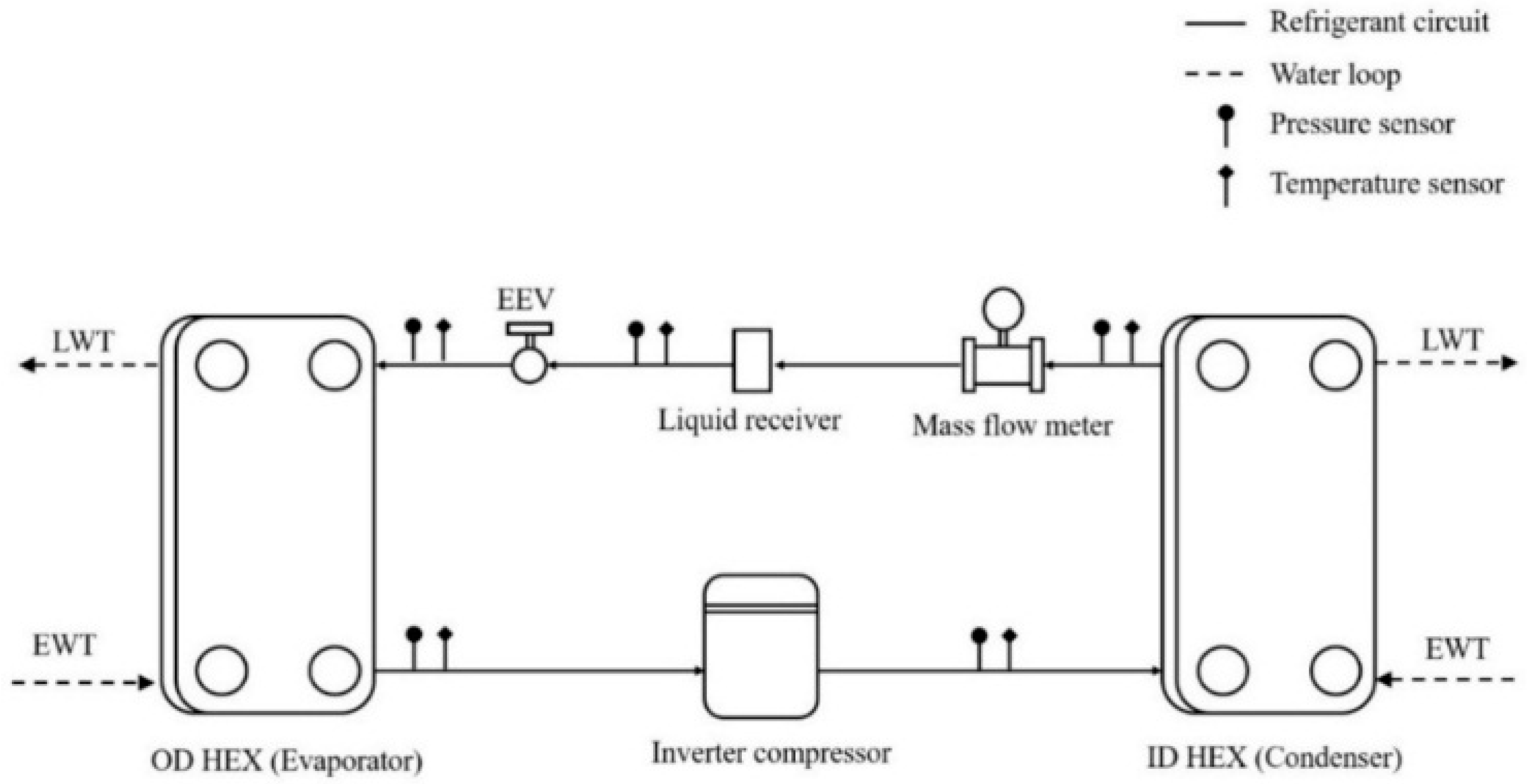
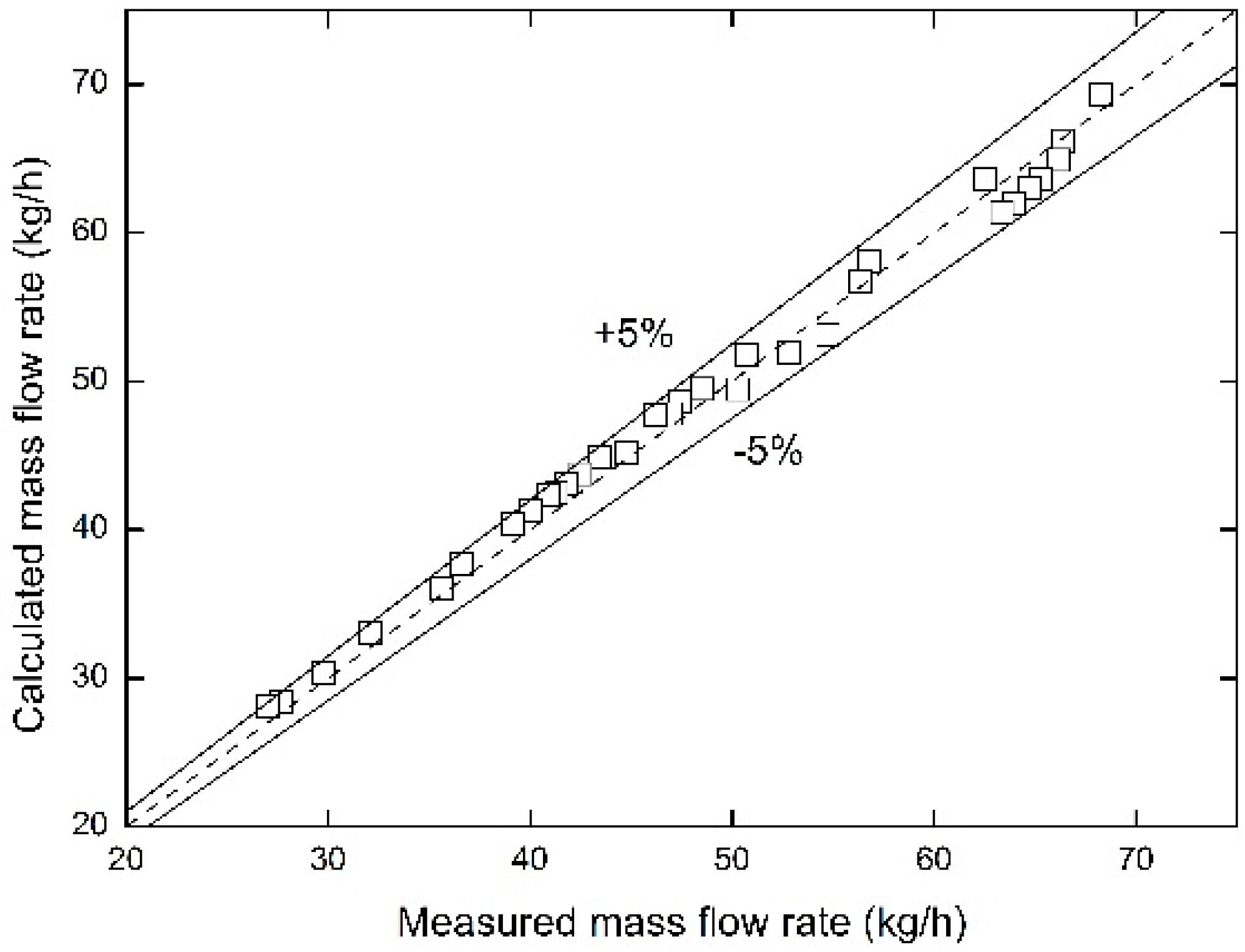
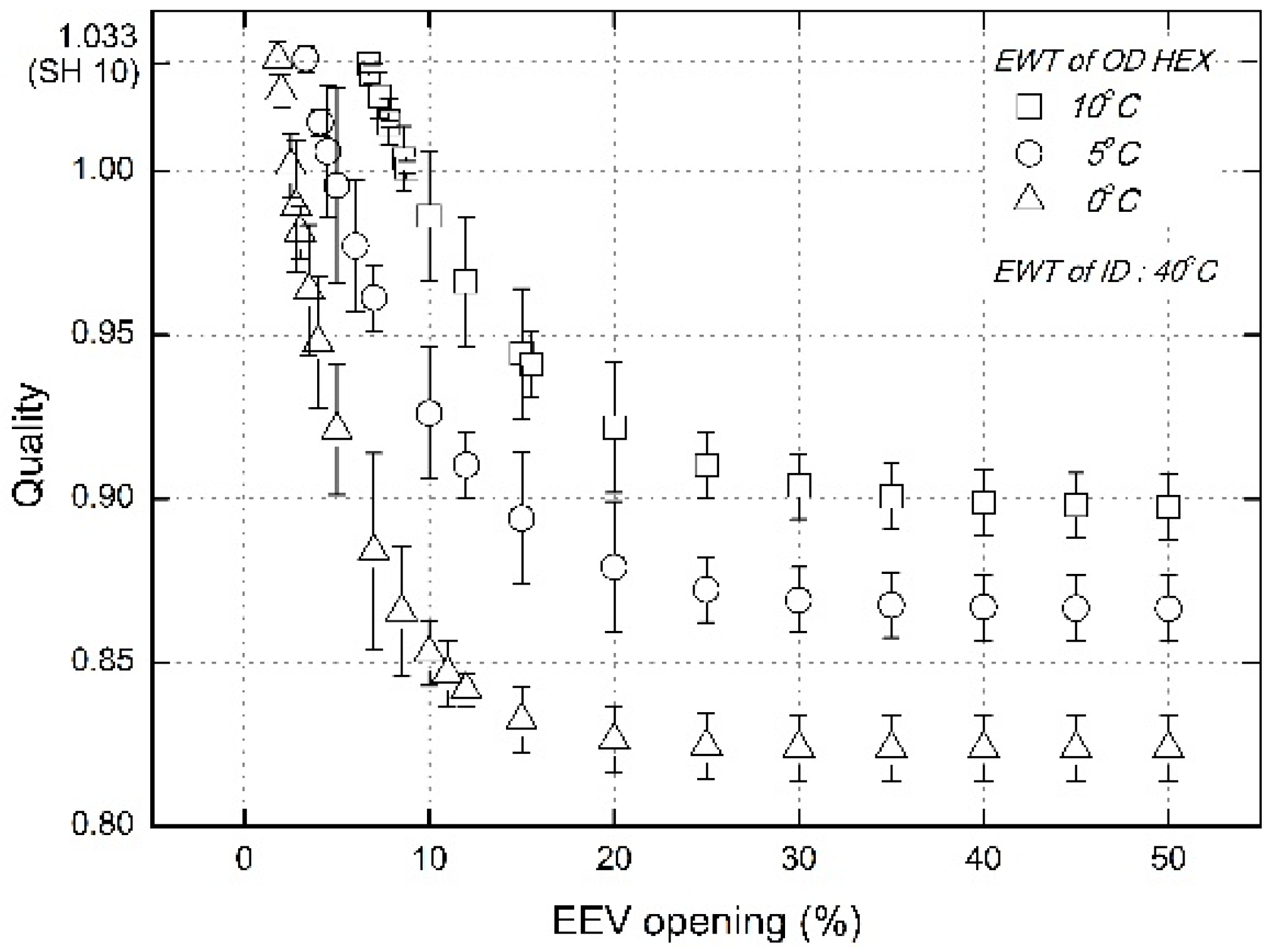
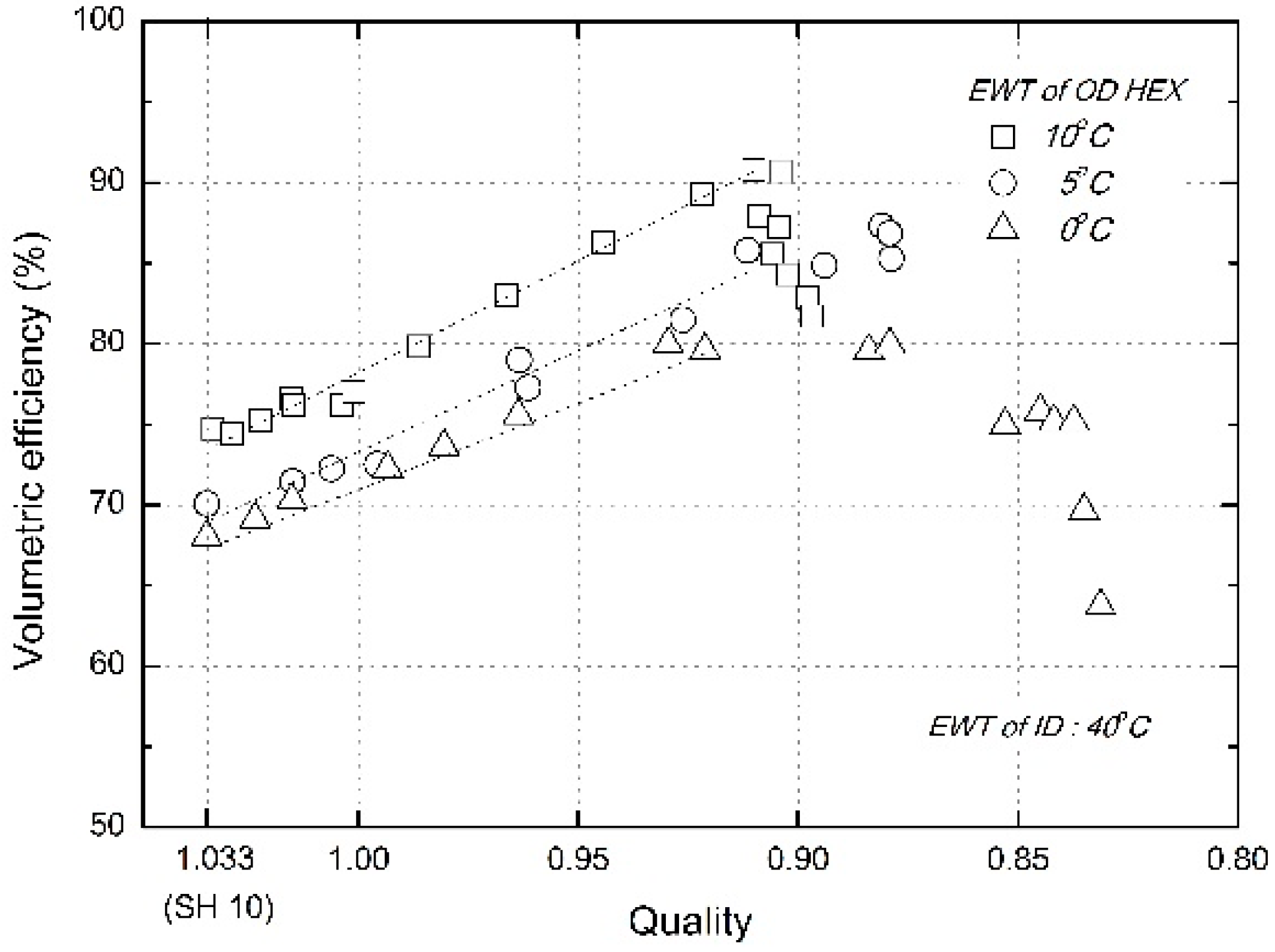

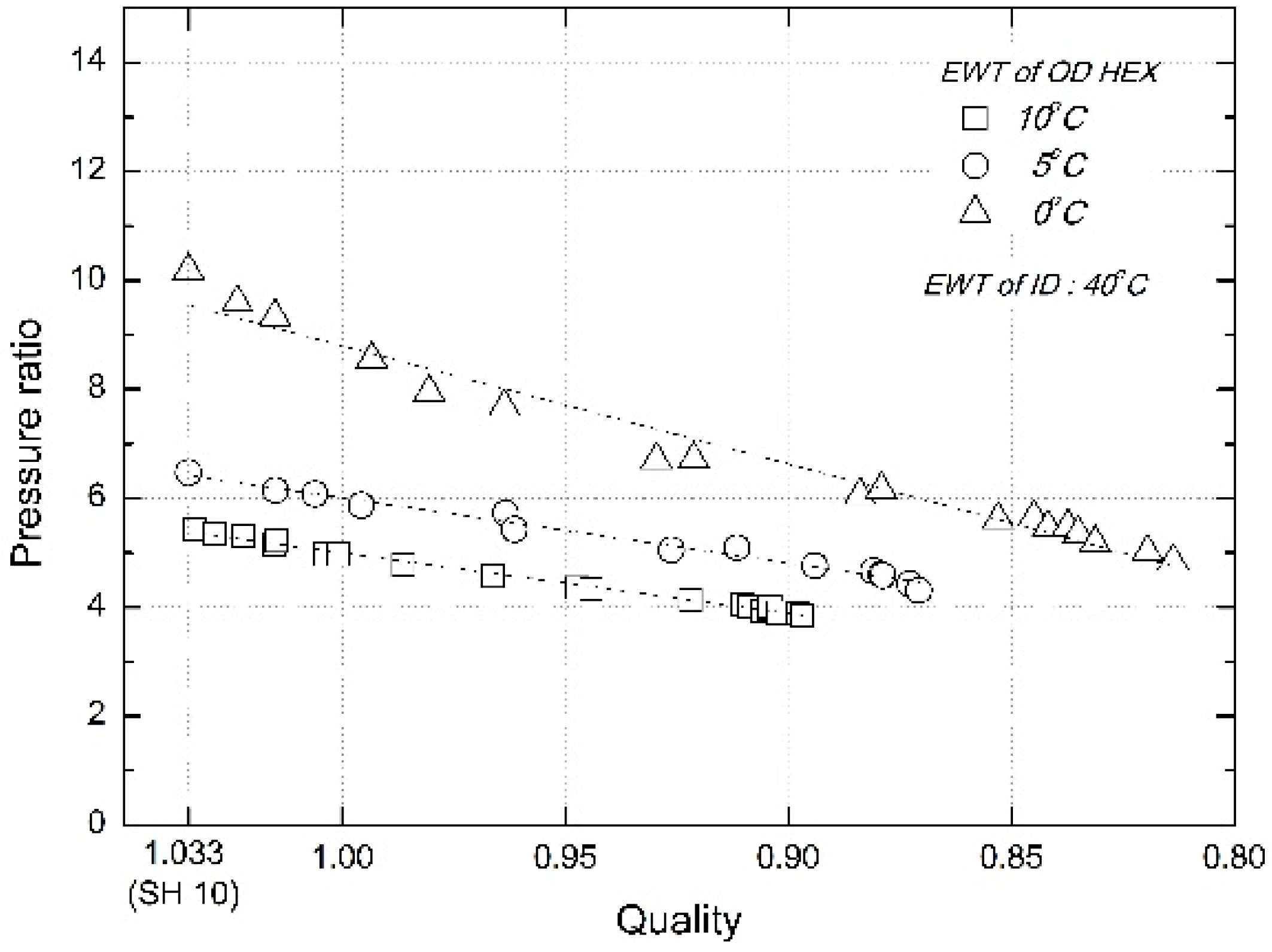
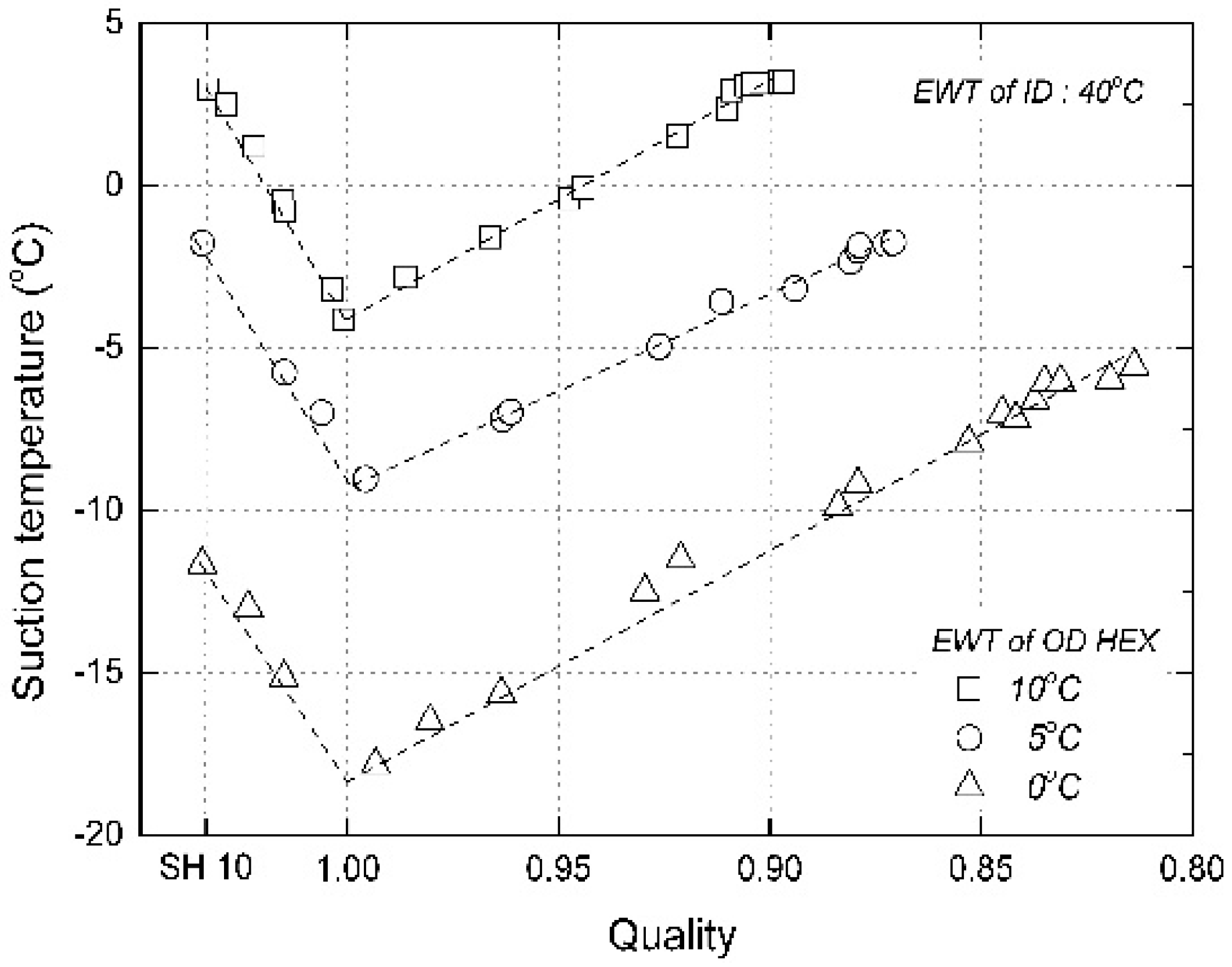
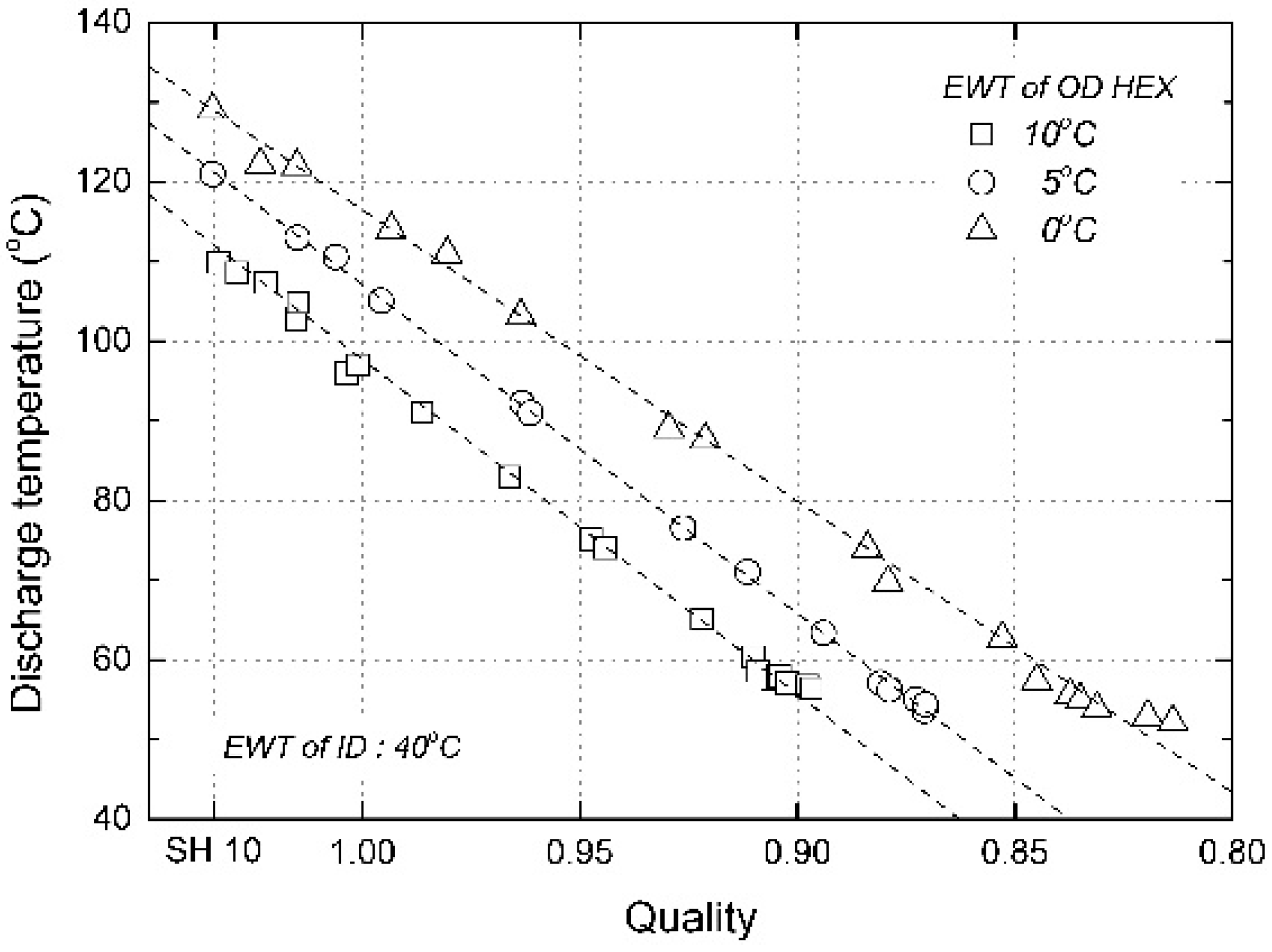
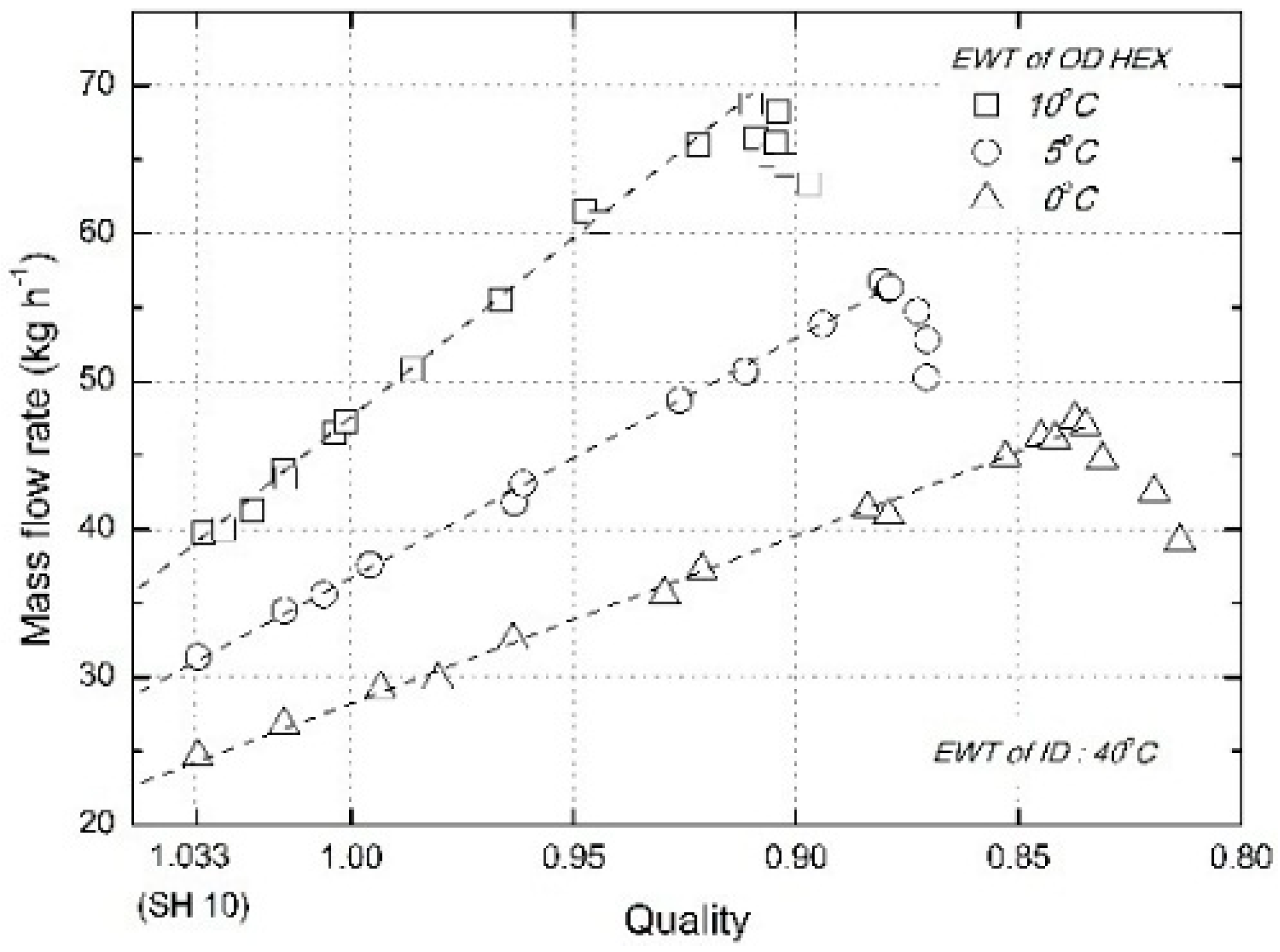


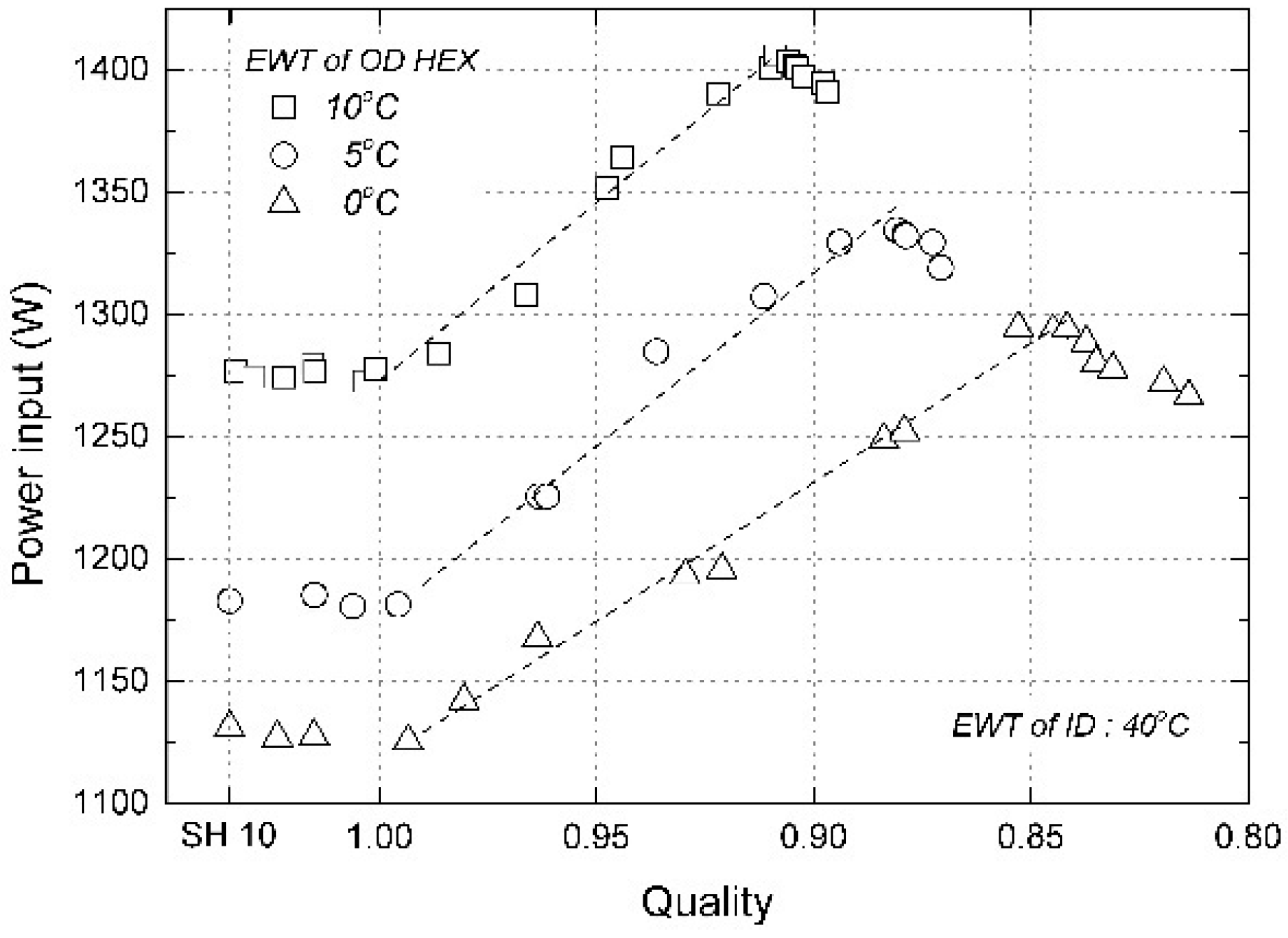

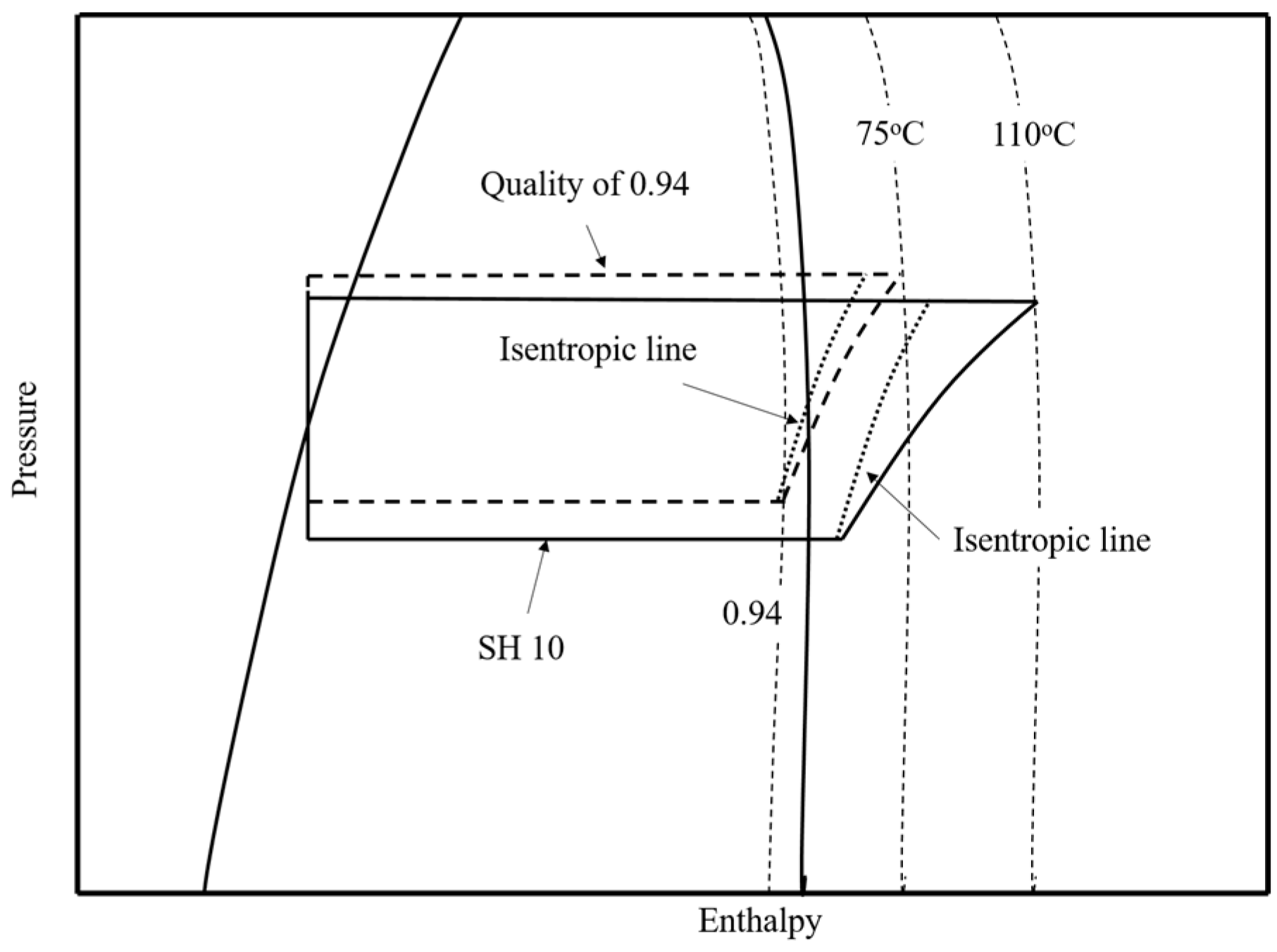
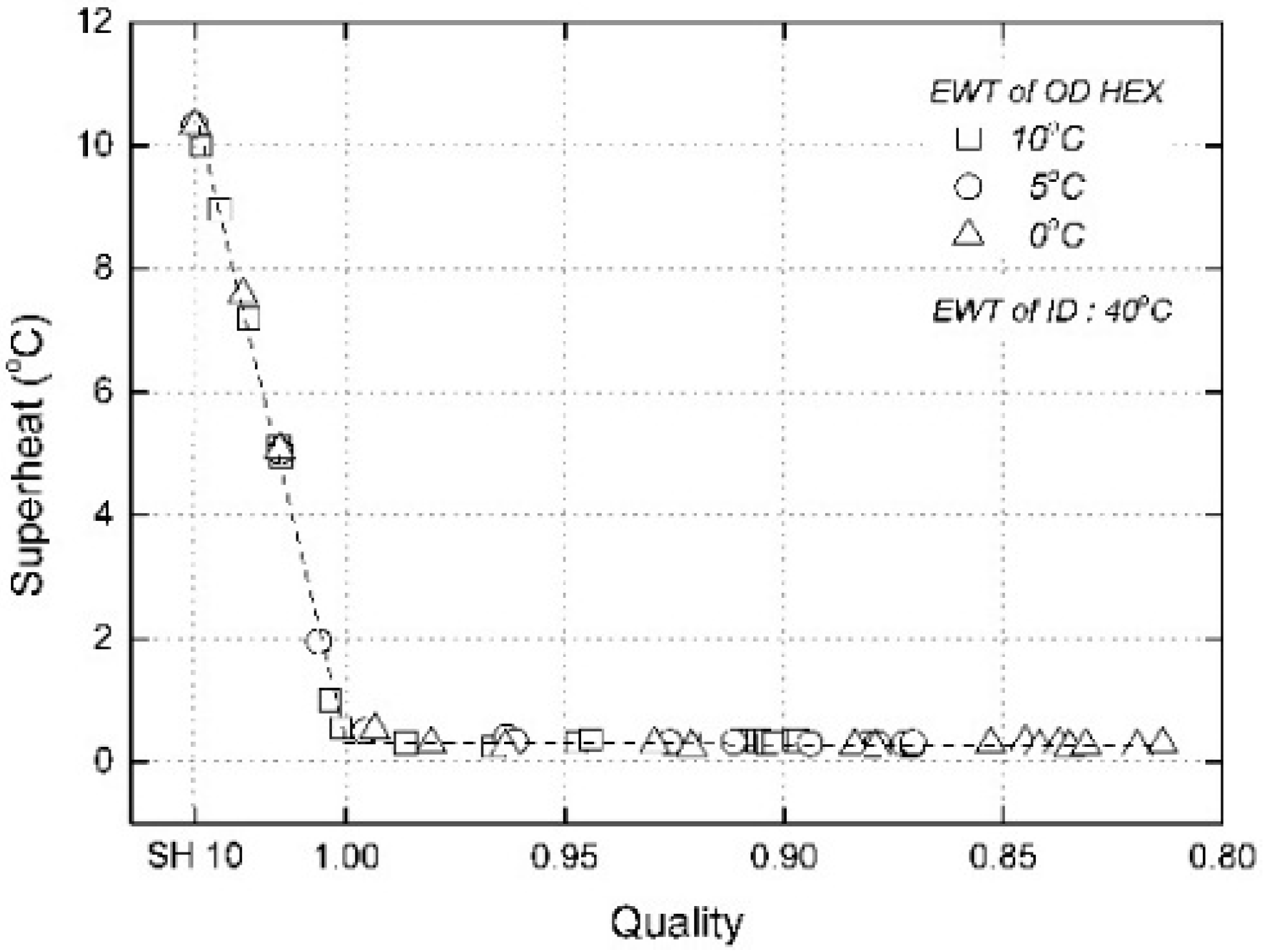

| Components | Specification |
|---|---|
| Indoor heat exchanger | Manufacturer: Danfoss Model No.: B3-030-20-3.0-HQ Type: Brazed plate type heat exchanger |
| Outdoor heat exchanger | |
| Compressor | Manufacturer: LG Model: GA102MFB Type:Inverter Hermetic Rotary compressor Displacement: 10.2 CC Nominal cooling capacity: 3.5 kW |
| Electric Expansion Valve | Manufacturer: Sanhua Model No. DPF(o) 1.4 Step (pulse): 2000 Orifice diameter: 1.4 mm |
| TEST | Indoor heat exchanger | Outdoor heat exchanger | ||||
|---|---|---|---|---|---|---|
| EWT (Entering Water Temperature) | WFR (Water Flow Rate) | Discharge Pressure | EWT | WFR | Suction Pressure | |
| ISO 13256-2 | 40 °C | 0.6 m3·h−1 | 2946 kPa | 10 °C | 0.6 m3·h−1 | 543 kPa |
| 2846 kPa | 5 °C | 440 kPa | ||||
| 2800 kPa | 0 °C | 275 kPa | ||||
| Parameter | Uncertainty | Full Scale |
|---|---|---|
| Pressure transducer | ±0.3% | 50 bar |
| Temperature (T-type thermo-couples) at refrigerant side | ±0.5 °C | −200–400 °C |
| Temperature (Pt-100 ) at water side | ±0.1 °C | −100–100 °C |
| Mass flow meter | ±0.25% | 10 kg·min−1 |
| Turbine flow meter | ±0.5% | 2.2 m3·h−1 |
| Power meter | ±0.1% | 12 kW |
© 2017 by the authors. Licensee MDPI, Basel, Switzerland. This article is an open access article distributed under the terms and conditions of the Creative Commons Attribution (CC BY) license ( http://creativecommons.org/licenses/by/4.0/).
Share and Cite
Seong, K.; Lee, D.; Lee, J. The Effects of Wet Compression by the Electronic Expansion Valve Opening on the Performance of a Heat Pump System. Appl. Sci. 2017, 7, 248. https://doi.org/10.3390/app7030248
Seong K, Lee D, Lee J. The Effects of Wet Compression by the Electronic Expansion Valve Opening on the Performance of a Heat Pump System. Applied Sciences. 2017; 7(3):248. https://doi.org/10.3390/app7030248
Chicago/Turabian StyleSeong, Kyoungjin, Daehui Lee, and Jinho Lee. 2017. "The Effects of Wet Compression by the Electronic Expansion Valve Opening on the Performance of a Heat Pump System" Applied Sciences 7, no. 3: 248. https://doi.org/10.3390/app7030248





